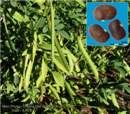Scientific name(s)
Clitoria ternatea
Strengths
- Easy to establish.
- Persistent in areas with a long dry season.
- High forage and seed production.
- Some tolerance to salinity and sodicity.
- Very palatable, high digestibility and protein content and does not cause bloat.
- No major pests or diseases.
- Improves soil fertility.
- Easily killed with herbicide in crop land.
Limitations
- Adapted to soils with high fertility and high water holding capacity.
- No winter growth in the sub-tropics.
- Does not tolerate prolonged heavy grazing.
Plant description
Plant: Perennial herbaceous legume with fine twining or climbing stems from 0.5 to 3m long.
Stems: Older stems are woody and light (usually grey) in colour. Young stems are green and when actively growing have fine twining new growth.
Leaves: Pinnate with 5 or 7 leaflets. Leaflets are elliptic to narrowly lanceolate 1.5 to 5 cm long and 0.3 to 3 cm wide.
Flowers: Usually single and range in colour from white, mauve, light blue to dark blue.
Pods: Flattened 4 to 13 cm long and 0.8 to 1.2 cm wide with margins thickened, sparse hair when mature and pale brown.
Seeds: Olive brown to black, shiny and often mottled, 8 to 11/pod 4.5 to 7 mm long and 3 to 4 mm wide, 23,000 seeds/kg.
Pasture type and use
Used as a ley legume in cropping systems planted either as a forage crop or with grasses and in perennial grass legume pastures. Persistence can be compromised under continuous heavy grazing. Makes high quality hay if cut when actively growing before pods form. Also used in mine site revegetation in central Queensland.
Where it grows
Rainfall
Best adapted to areas with 650 to 1250 mm but can persist with summer rainfall of 500 mm.
Soils
Adapted to a wide range of soil types provided fertility and water-holding capacity is high. Prefers medium to high pH and is well adapted to alkaline heavy clay soils.
Temperature
Highest growth occurs in summer when temperatures are > 27oC. Tolerates average daily temperatures as low as 15oC but growth is slow in spring. Not suited to areas with severe or frequent frosts.
Establishment
Companion species
Grasses: Buffel grass, green and Gatton panic, Bambatsi panic, rhodes grass, Floren bluegrass, purple pigeon grass,
Sowing/planting rates as single species
7 to 10 kg/ha; plant density target should be 10 to 15 plants/m2.
Sowing/planting rates in mixtures
2 to 4 kg/ha; plant density should be not less than 5 plants/m2.
Sowing time
Late spring to summer. Planting following rain in January to March is the most reliable time in central Queensland when there is a high probability of follow-up rain for the emerging seedlings.
Inoculation
Tropical group M (Siratro)
Fertiliser
Not normally required when planted on suitable soils but could respond to P and S on less fertile soils.
Management
Maintenance fertliser
Not normally required when planted on fertile soils but could respond to P and S on less fertile soils.
Grazing/cutting
In the first season grazing should be delayed until plants have set seed (14 to 20 weeks). This provides seed for regeneration which is necessary to maintain legume density and allows it to develop a woody frame. Subsequently it can be grazed heavily in a rotation but continuous heavy grazing will reduce legume density. For hay making butterfly pea should be cut when 50 to 60 cm high and before pods are formed. Cutting should not be lower than 7 to 10 cm to allow plants to regrow from the woody frames.
Seed production
Butterfly seed crops are high yielding. Seed yields usually range from 200 to 500kg/ha but can be up to 900kg/ha. Because it is indeterminate in growth habit it is common to have mature seed, green pods and flowers at the same time. Desiccation prior to harvesting can be beneficial. The aim is to harvest when 90% of the seed is hard and black.
Ability to spread
Very limited ability to spread in grazed pastures.
Weed potential
Very low. In grazed pasture it is unlikely to spread because palatability is high and seedlings do not compete well with established plants. Herbicides used to control broadleaf weeds in crops are effective against butterfly pea.
Major pests
None. It is tolerant of most insects but leaf-eating caterpillars and grasshoppers can be a minor problem.
Major diseases
No serious disease in CQ but can be infected with fungal leaf diseases in wetter areas.
Herbicide susceptibility
Susceptible to glyphosate at low (<800ml/ha) rates. Susceptible to metsulfuron methyl (Ally) fluroxypyr (Starane), MCPA and 2,4-D.
Animal production
Feeding value
Leaf protein and digestibility is very high and as high as or higher than for other legumes. Nitrogen concentrations can be > 4% for leaf and 2% for stem.
Palatability
Generally very palatable and selectively grazed.
Production potential
Annual yields of legume and legume/grass pastures when grown in dryland areas can be up to 6 tonnes/ha. Cattle grazing butterfly pea pastures can gain rapidly in summer (> 1kg/head/day) but over a full year of grazing liveweight gains of 220kg/head/year (0.6 kg/head/day) attainable.
Livestock disorders/toxicity
None known
Cultivars
| Cultivar | Seed source/Information |
| Milgarra | Southedge seedsHeritage SeedsAustralian Herbage Plant Cultivars |
Further information
Tropical Forages database (SoFT) - Butterfly pea
The butterfly pea book – a guide to establishing and managing butterfly pea pastures in central
Acknowledgements
-
Author and date
Bob Clem
December 2008





